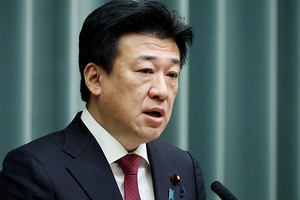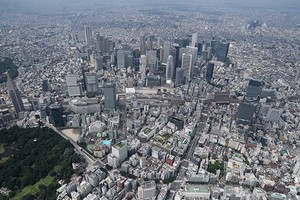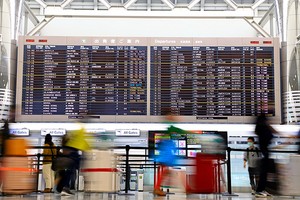THE ASAHI SHIMBUN
April 10, 2025 at 16:54 JST
A preview of the Osaka Kansai Expo 2025 on April 9 days before its opening showed a number of contrasting exhibits that emphasize both humanity's ingenuity and violence.
Among the pavilions and attractions unveiled four days early to the media on the reclaimed island of Yumeshima are a “flying car” exhibit and the experience of “meeting yourself 25 years from now.”
The expo, which runs from April 13 to Oct. 13, touts its highlights as giving visitors access to the latest technology as well as encouraging them to envision the future and contemplate a sustainable society.
With numerous triangles arranged in a mesh-like pattern to resemble a bird's nest, the Osaka Healthcare Pavilion's attractions span more than one floor.
Booths on the first floor automatically register a visitor's data such as hair, skin and skeletal structure. Upon moving to the second floor, they will be met with an avatar of what they will supposedly look like in 25 years.
Also on display in the same pavilion is the “future human washing machine," an evolution of the egg-shaped ultrasonic bath that garnered attention at the 1970 Expo held in Osaka Prefecture half a century ago.
A demonstration of this new iteration will be held during the expo.
After simply sitting inside the machine, fine bubbles wash over the bather as a sensor on the back of the machine measures their heart rate and other related readings.
In the realm of medical breakthroughs, Pasona Group Inc.'s Pasona Natureverse pavilion is showcasing a beating heart created from iPS (induced pluripotent stem) cells.
Over at the towering Grand Ring, which is the symbol of the expo, visitors can take an elevator up to the top of the structure.
Awaiting them is a bird's-eye view of the pavilions from all over the world lining the ring, which has a circumference of 2 kilometers, and a panorama of the Osaka Bay area beyond the Expo grounds.
Sobering, but no less important exhibits include the United Nations Pavilion covering the entity's 80-year history since its establishment and features the undertakings of 35 U.N. agencies and 15 departments.
The United Nations Relief and Works Agency for Palestinian Refugees in the Near East (UNRWA) that operates in Palestine's Gaza Strip is one group featured.
In addition to touch panels that provide an overview of UNRWA activities is a display of refugee registration cards.
A portion of the exhibit changes weekly and a virtual reality experience corner for conflict zones in Gaza and Ukraine is scheduled to be installed in August.
This is an attempt to give visitors an on-the-ground experience what it is like to be in a life-threatening war zone through goggles simulating the environment and sounds of those areas.
Maher Nasser, the pavilion's director, hails from Palestine and has worked as an UNRWA official in Gaza.
He said that the pavilion intends to convey the message that there are no winners in conflicts and wars, and that peace is the greatest value that can be shared with people around the globe.
(This article was written by Tsutomu Ishiai, Shinichi Kawarada, Keitaro Nishizaki and Hana Matsuo.)




















A peek through the music industry’s curtain at the producers who harnessed social media to help their idols go global.
A series based on diplomatic documents declassified by Japan’s Foreign Ministry
Here is a collection of first-hand accounts by “hibakusha” atomic bomb survivors.
Cooking experts, chefs and others involved in the field of food introduce their special recipes intertwined with their paths in life.
A series about Japanese-Americans and their memories of World War II